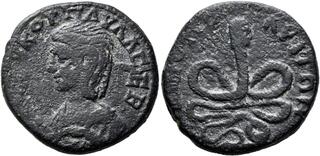| Leu Numismatik AG > Web Auction 28 | Auction date: 9 December 2023 |
| Lot number: 2221 Price realized: 220 CHF (Approx. 250 USD / 232 EUR) Note: Prices do not include buyer's fees. | Show similar lots on CoinArchives Find similar lots in upcoming auctions on |
| Lot description: PAPHLAGONIA. Ionopolis. Julia Paula, Augusta, 219-220. Diassarion (Bronze, 23 mm, 8.45 g, 7 h). ΙΟΥ ΚΟΡ ΠΑΥΛΑ CΕΒ Draped bust of Julia Paula to left, holding poppy flower in her right hand. Rev. IΩNOΠΟΛITΩN The snake-god Glykon as a coiled serpent with human head to right. RPC VI online 30500 (this coin). Unique. Smoothed and repatinated, otherwise, about very fine. From the Jay Smith Collection of coins of Elagabalus, ex Zeus E-Auction 25, 23 October 2022, 396 (misdescribed). The reverse of this very interesting issue shows Glykon, a long-haired serpent around which Alexander of Abonoteichus created a new cult in the mid 2nd century. His contemporary Lucian described Alexander as an utter charlatan who deceived his followers by outfitting a serpent with a puppet head and a blond wig, which he then propagated as a reincarnation of Asklepios named Glykon. Alexander established a widely popular oracle in his home town of Abonoteichus around the charade, where he charged 2 drachms and two obols for every consultation, thereby earning a fortune. In 166, Alexander reportedly sent Marcus Aurelius an oracle revealing that the drowning of two living lions in the Danube would lead to a decisive victory in the war against the Marcomanni. When the emperor suffered a defeat, the false prophet resorted to the very same excuse the oracle in Delphi had given when she predicted to Kroisos that his attack on the Persians would lead to the destruction of a mighty kingdom. Namely, that he had not said which side would win. Nevertheless, the worship of Glykon enjoyed great popularity well into the 3rd century and became, as these very rare coins from Abonoteichus show, a source of civic pride for Alexander's home town. Starting price: 75 CHF |  |



